HTML
--> --> -->There is a significant correspondence between the zonal shift of the WNPSH and the meridional displacement of the EAJ, that is, the westward extension (eastward retreat) of the WNPSH is closely associated with the southward (northward) shift of the EAJ (Wang et al., 2001; Lu, 2004; Lu and Lin, 2009; Li and Lu, 2020). The interannual variations of the WNPSH and EAJ are closely associated with the anomalous convection and/or precipitation over the tropical western North Pacific (WNP) (Lu, 2001; Lu and Dong, 2001). Suppressed (enhanced) precipitation over the tropical WNP induces an anticyclonic (cyclonic) anomaly in the lower troposphere to the northwest, which corresponds to the westward extension (eastward retreat) of the WNPSH and the southward (northward) displacement of the EAJ. On the other hand, the anticyclonic (cyclonic) anomaly is favorable for enhanced (suppressed) precipitation along the subtropical East Asian rainy belt, including the Yangtze River basin, by affecting moisture transport (Huang and Sun, 1992; Wang et al., 2001; Zhou and Yu, 2005; H. Li et al., 2019; X. Z. Li et al., 2019). A southward (northward) displaced EAJ also favors enhanced (reduced) subtropical rainfall (Liang and Wang, 1998; Lu, 2004; Xuan et al., 2011; Li and Zhang, 2014; Li and Lu, 2017; Yan et al., 2019). Both the WNPSH–EAJ relationship and subtropical rainy belt are components of the well-known meridional teleconnection over the WNP and East Asia (WNP–EA), i.e., the Pacific–Japan pattern (Nitta, 1987) or East Asia–Pacific pattern (Huang and Sun, 1992).
It has been well reported that the tropical sea surface temperature (SST) anomalies, especially the evolution of El Ni?o–Southern Oscillation (ENSO), play an important role in affecting the WNPSH and EAJ. During the mature phase of El Ni?o, an anticyclonic anomaly develops over the tropical WNP. This anticyclonic anomaly can be maintained into the following summer through local air-sea interactions (Wang et al., 2003) or the Indian Ocean capacitor effect (Terao and Kubota, 2005; Yang et al., 2007; Li et al., 2008; Xie et al., 2009; Yun et al., 2013; Xie et al., 2016), and corresponds to the westward extension of the WNPSH and southward shift of the EAJ. The tropical, summer SSTs which occur simultaneously also affect the WNPSH and EAJ. For instance, the SST warming (cooling) over the tropical central and eastern Pacific in summer favor more (less) rainfall over the tropical WNP and thus a cyclonic (anticyclonic) anomaly to the northwest (Lau and Nath, 2006; Wang et al., 2013). Besides, these SST anomalies can induce homogenous tropospheric warming (cooling) in the tropics, and the associated thermal wind leads to the meridional shift of the mid-latitude jet (Held and Hou, 1980; Bretherton and Sobel, 2003; Seager et al., 2003; Chen et al., 2008; Lu et al., 2008; Lin and Lu, 2009; Lin, 2010; Sun et al., 2013; Kong and Chiang, 2020).
Although there are tropical–extratropical connections over the WNP–EA, the meridional shift of the EAJ is not forced entirely by tropical heating. In particular, it is not guaranteed that the westward extension (eastward retreat) of the WNPSH will always correspond to the southward (northward) shift of the EAJ. That is, in some years, a westward extended WNPSH may co-exist with a northward displaced EAJ, or an eastward retreated WNPSH may co-exist with a southward displaced EAJ. While focusing on the anomalies associated with individual WNPSH and EAJ, previous studies ignored the configurations of the WNPSH and EAJ. Hereafter, these two configurations, i.e., the general and uncommon ones, are called in-phase and out-of-phase configurations, respectively. The anomalies of different WNPSH–EAJ configurations, especially the out-of-phase configuration, are necessary supplements to the well-known tropical–extratropical connections over WNP–EA. Furthermore, we will investigate the possible mechanism for the occurrence of different configurations, focusing on the roles of tropical SSTs. Recently, Li and Lu (2020) reported that the simultaneous summer SST cooling in the tropical central and eastern Pacific results in the absence of WNPSH–EAJ correspondence after the early 2000s, in sharp contrast to the previously well-known phenomenon, i.e., the decay of El Ni?o favors the westward extension of the WNPSH and southward shift of the EAJ. These results suggest that tropical SSTs may affect different configurations of the WNPSH and EAJ on interannual timescales, which is also to be tested in this study.
The rest of this paper is organized as follows. Section 2 describes the data, indices, and methods used in this study. In section 3, we investigate the circulation and precipitation anomalies associated with different configurations of the WNPSH and EAJ. Section 4 further explores the role of evolving tropical SSTs in affecting the WNPSH–EAJ correspondences. Section 5 provides a summary.
We define two indices to facilitate the description of the WNPSH–EAJ correspondences. The WNPSH index (WNPSHI) is defined as the difference of the JJA-mean 850-hPa zonal winds between the averages over (20°–30°N, 110°–140°E) and (5°–15°N, 100°–130°E). This definition follows Wang et al. (2001), but with the opposite sign. Thus, a positive (negative) WNPSHI represents an anticyclonic (cyclonic) anomaly over the tropical WNP and the westward extension (eastward retreat) of the WNPSH. The EAJ index (EAJI), which is used to measure the meridional displacement of the EAJ, is defined as the difference in the area-averaged JJA-mean 200-hPa zonal winds between (30°–40°N, 120°–150°E) and (40°–50°N, 120°–150°E) , which are located to the south and north of the climatological jet axis, respectively (Lu, 2004). A positive (negative) EAJI indicates the southward (northward) displacement of the EAJ. In addition, the Ni?o-3 index is defined as SST anomalies averaged over (5°S–5°N, 150°–90°W) (e.g., Yang et al., 2007).
The main statistical methods used in the present study include composite, regression, and correlation analyses. A Student’s t-test is used to determine the statistical significance of the analyzed results.
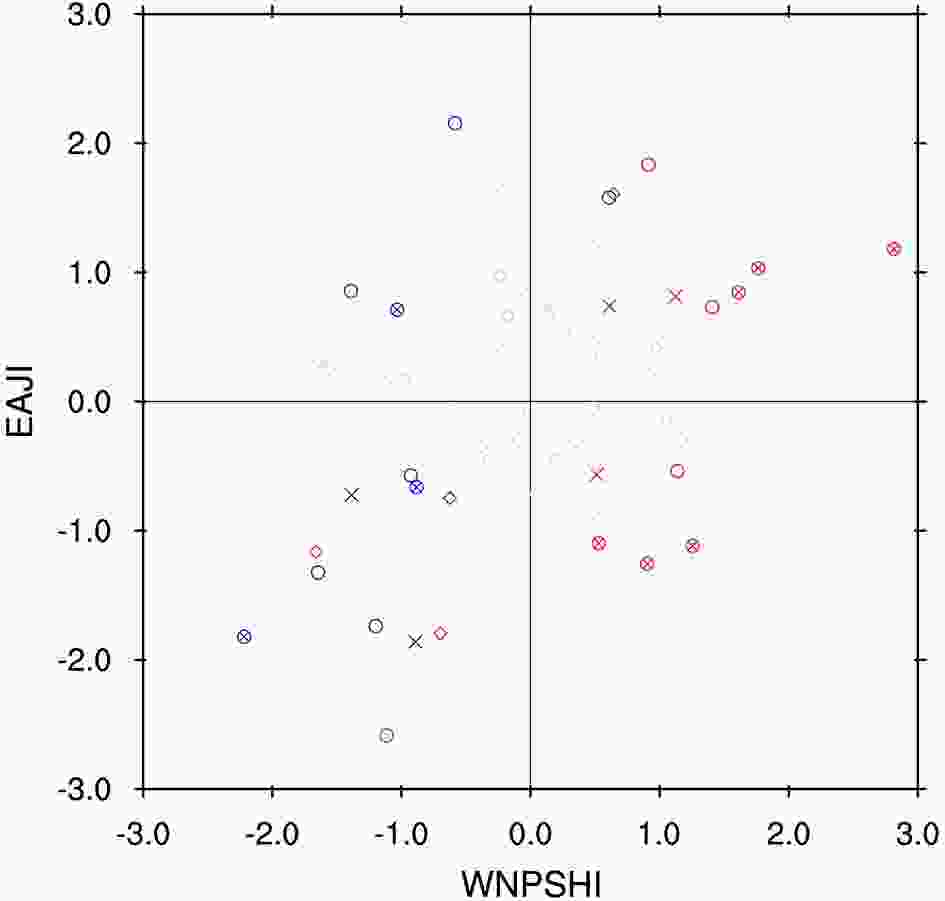 Figure1. Scatter diagram of the standardized WNPSHI (abscissa) and EAJI (ordinate) during 1958–2019. Red and blue cases indicate the years in which the absolute values of WNPSHI and EAJI are both greater than 0.5 standard deviations from the mean. The red (blue) circles represent the decaying (developing) year of El Ni?o; red (blue) cross denotes the developing (decaying) year of La Ni?a, and the red (blue) circle-cross indicates the year with both El Ni?o (La Ni?a) decaying and La Ni?a (El Ni?o) developing. ENSO decaying or developing years are identified according to the generally-accepted criterion that the three-month running mean of SSTs in the Ni?o-3.4 region (5°S–5°N, 170°–120°W) exceeds the threshold of ±0.5°C for a minimum of five consecutive overlapping seasons (http://www.cpc.ncep.noaa.gov/products/analysis_monitoring/ensostuff/ensoyears.shtml).
Figure1. Scatter diagram of the standardized WNPSHI (abscissa) and EAJI (ordinate) during 1958–2019. Red and blue cases indicate the years in which the absolute values of WNPSHI and EAJI are both greater than 0.5 standard deviations from the mean. The red (blue) circles represent the decaying (developing) year of El Ni?o; red (blue) cross denotes the developing (decaying) year of La Ni?a, and the red (blue) circle-cross indicates the year with both El Ni?o (La Ni?a) decaying and La Ni?a (El Ni?o) developing. ENSO decaying or developing years are identified according to the generally-accepted criterion that the three-month running mean of SSTs in the Ni?o-3.4 region (5°S–5°N, 170°–120°W) exceeds the threshold of ±0.5°C for a minimum of five consecutive overlapping seasons (http://www.cpc.ncep.noaa.gov/products/analysis_monitoring/ensostuff/ensoyears.shtml).The scatter diagram divides all the samples into four categories, i.e., two in-phase configurations (WNPSHI+ EAJI+ and WNPSHI? EAJI?) and two out-of-phase configurations (WNPSHI+ EAJI? and WNPSHI? EAJI+). We choose the years in which the absolute values of WNPSHI and EAJI are both greater than 0.5 standard deviations and perform composite analyses based on these years. This criterion yields nine (WNPSHI+ EAJI+) cases, three (WNPSHI? EAJI+) cases, 11 (WNPSHI? EAJI?) cases, and five (WNPSHI+ EAJI?) cases, respectively (Fig. 1). It was found that the circulation, precipitation, and SST anomalies are basically anti-symmetric between the two in-phase configurations, and also between the two out-of-phase configurations (not shown). Therefore, the composite difference between the two in-phase and that between the two out-of-phase configurations (i.e., WNPSHI+ EAJI+ minus WNPSHI? EAJI? and WNPSHI+ EAJI? minus WNPSHI? EAJI+) are used to represent the in-phase and out-of-phase anomalies, respectively. The in-phase and out-of-phase configurations are both associated with positive WNPSHI, but positive and negative EAJI, respectively.
In addition, to make comparisons between the WNPSH–EAJ configurations and those associated with the individual WNPSH or EAJ, we also select the cases with the absolute values of WNPSHI or EAJI greater than 0.5 standard deviations and perform composite analyses based on these cases. There are 20 WNPSHI+ cases, 20 WNPSHI? cases, 21 EAJI+ cases, and 19 EAJI? cases selected. The composite difference between the WNPSHI+ and WNPSHI? cases and that between the EAJI+ and EAJI? cases are used to represent the anomalies associated with individual WNPSHI and EAJI, respectively.
2
3.1. Circulation anomalies
Figure 2 shows the 850-hPa horizontal wind anomalies (UV850) associated with the in-phase and out-of-phase configurations of the WNPSHI and EAJI, respectively. For the in-phase configuration (Fig. 2a), there is a significant anticyclonic anomaly over the subtropical WNP, suggesting a westward extension of the WNPSH. A cyclonic anomaly appears over the mid-latitudes of East Asia, in association with the southward shift of the upper-tropospheric EAJ (Li and Lu, 2017). In addition, there is another anticyclonic anomaly over Northeast Asia. These circulation anomalies manifest themselves as the meridional teleconnection over WNP–EA (Huang and Sun, 1992; Lu and Lin, 2009; Kosaka et al., 2011). In contrast, the UV850 anomalies associated with the out-of-phase configuration show distinctly different features (Fig. 2b). There is still an anticyclonic anomaly over the subtropical WNP, however, this anticyclonic anomaly extends more northward and occupies a much larger meridional scope. Associated with this anticyclonic anomaly, there are southwesterly and westerly anomalies in North China and central Japan, which is associated with a northward shift of the upper-tropospheric EAJ. Figure2. The 850-hPa horizontal wind anomalies (UV850; units: m s?1) associated with the (a) in-phase and (b) out-of-phase configurations of the WNPSHI and EAJI, respectively. Cases with the absolute values of WNPSHI and EAJI both greater than 0.5 standard deviations from the mean are used. The anomalies here refer to the composite difference between the two in-phase configurations and that between the two out-of-phase configurations, i.e., WNPSHI+ EAJI+ minus WNPSHI? EAJI? and WNPSHI+ EAJI? minus WNPSHI? EAJI+, respectively. “AC” and “C” represent the anticyclonic and cyclonic anomaly, respectively. The difference in area-averaged, JJA-mean 850-hPa zonal winds between the two marked regions in (a) is used to define the WNPSHI (see text for details). Shadings indicate that either the zonal or meridional wind anomalies are significant at the 95% confidence level based on a Student’s t-test.
Figure2. The 850-hPa horizontal wind anomalies (UV850; units: m s?1) associated with the (a) in-phase and (b) out-of-phase configurations of the WNPSHI and EAJI, respectively. Cases with the absolute values of WNPSHI and EAJI both greater than 0.5 standard deviations from the mean are used. The anomalies here refer to the composite difference between the two in-phase configurations and that between the two out-of-phase configurations, i.e., WNPSHI+ EAJI+ minus WNPSHI? EAJI? and WNPSHI+ EAJI? minus WNPSHI? EAJI+, respectively. “AC” and “C” represent the anticyclonic and cyclonic anomaly, respectively. The difference in area-averaged, JJA-mean 850-hPa zonal winds between the two marked regions in (a) is used to define the WNPSHI (see text for details). Shadings indicate that either the zonal or meridional wind anomalies are significant at the 95% confidence level based on a Student’s t-test.The UV850 anomalies induced by the in-phase and out-of-phase configurations resemble those associated with the first and second EOF modes associated with the East Asian summer monsoon (Sun et al., 2010; Greatbatch et al., 2013; Ding et al., 2014, 2015; Li et al., 2018), respectively, suggesting that different configurations of the WNPSH and EAJ dominate the lower-tropospheric circulation anomalies over the WNP–EA. Additionally, these UV850 anomalies also show great similarities with the circulation anomalies that contribute to the predictability and unpredictability of the meridional teleconnection in climate models, respectively (Lin et al., 2018), suggesting that the out-of-phase configuration contributes to the uncertainty in this regard.
Figure 3 shows the 200-hPa zonal wind (U200) anomalies associated with the in-phase and out-of-phase configurations of the WNPSHI and EAJI, respectively. For both the in-phase and out-of-phase configurations, there are westerly anomalies in the tropical WNP (Figs. 3a and 3b), which act as the upper-tropospheric counterpart of the easterly anomalies along the south flank of the lower-tropospheric anticyclonic anomaly (Figs. 2a and 2b). On the other hand, the extratropical anomalies are distinctly different between the in-phase and out-of-phase configurations. For the in-phase cases (Fig. 3a), there are positive anomalies to the south of the jet axis and negative anomalies to the north, indicating a southward displacement of the jet. The U200 anomalies are characterized by a typical meridional teleconnection from the tropics to the extratropics over the WNP–EA. However, for the out-of-phase cases (Fig. 3b), there are easterly anomalies to the south of the jet axis and westerly anomalies to the north, indicating a northward shift of the jet. These results indicate that the circulation anomalies associated with the in-phase and out-of-phase configurations of the WNPSH and EAJ are distinctly different.
 Figure3. Same as Fig. 2, but for the 200-hPa zonal wind anomalies. The contour interval is 2.0 m s?1, and zero contours are omitted. The difference in area-averaged, JJA-mean 200-hPa zonal winds between the two marked regions in (a) is used to define the WNPSHI (see text for details). The bold black lines represent the climatological jet axis. Here, the jet axis is determined based upon the first derivative of zonal winds being zero. Shadings indicate that the zonal wind anomalies are significant at the 95% confidence level based on a Student’s t-test.
Figure3. Same as Fig. 2, but for the 200-hPa zonal wind anomalies. The contour interval is 2.0 m s?1, and zero contours are omitted. The difference in area-averaged, JJA-mean 200-hPa zonal winds between the two marked regions in (a) is used to define the WNPSHI (see text for details). The bold black lines represent the climatological jet axis. Here, the jet axis is determined based upon the first derivative of zonal winds being zero. Shadings indicate that the zonal wind anomalies are significant at the 95% confidence level based on a Student’s t-test.The circulation anomalies associated with the in-phase configuration are similar to those associated with the individual WNPSHI or EAJI (Fig. 4), which exhibit as a meridional teleconnection pattern in both the lower and upper troposphere and have been well documented by previous studies (e.g., Wang and Fan, 1999; Zhang et al., 2003; Lu and Lin, 2009; Zhao et al., 2015). However, the anomalies for the in-phase configuration are stronger and more significant. For instance, the composite difference of WNPSHI between the two in-phase configurations is 5.09 m s?1, but only 1.76 m s?1 between the EAJI+ and EAJI? cases. The composite difference of EAJI between the two in-phase configurations is 10.91 m s?1, greater than that between the WNPSHI+ and WNPSHI? cases (3.88 m s?1). On the other hand, compared to the individual WNPSHI or EAJI, the tropical WNP anticyclonic anomaly for the out-of-phase WNPSHI–EAJI configuration extends more northward (Fig. 2b). This is because the northward shift of the EAJ corresponds to an anticyclonic anomaly in the mid-latitudes of East Asia in the lower troposphere (Li and Lu, 2017), which merges with the one associated with the westward extension of the WNPSH.
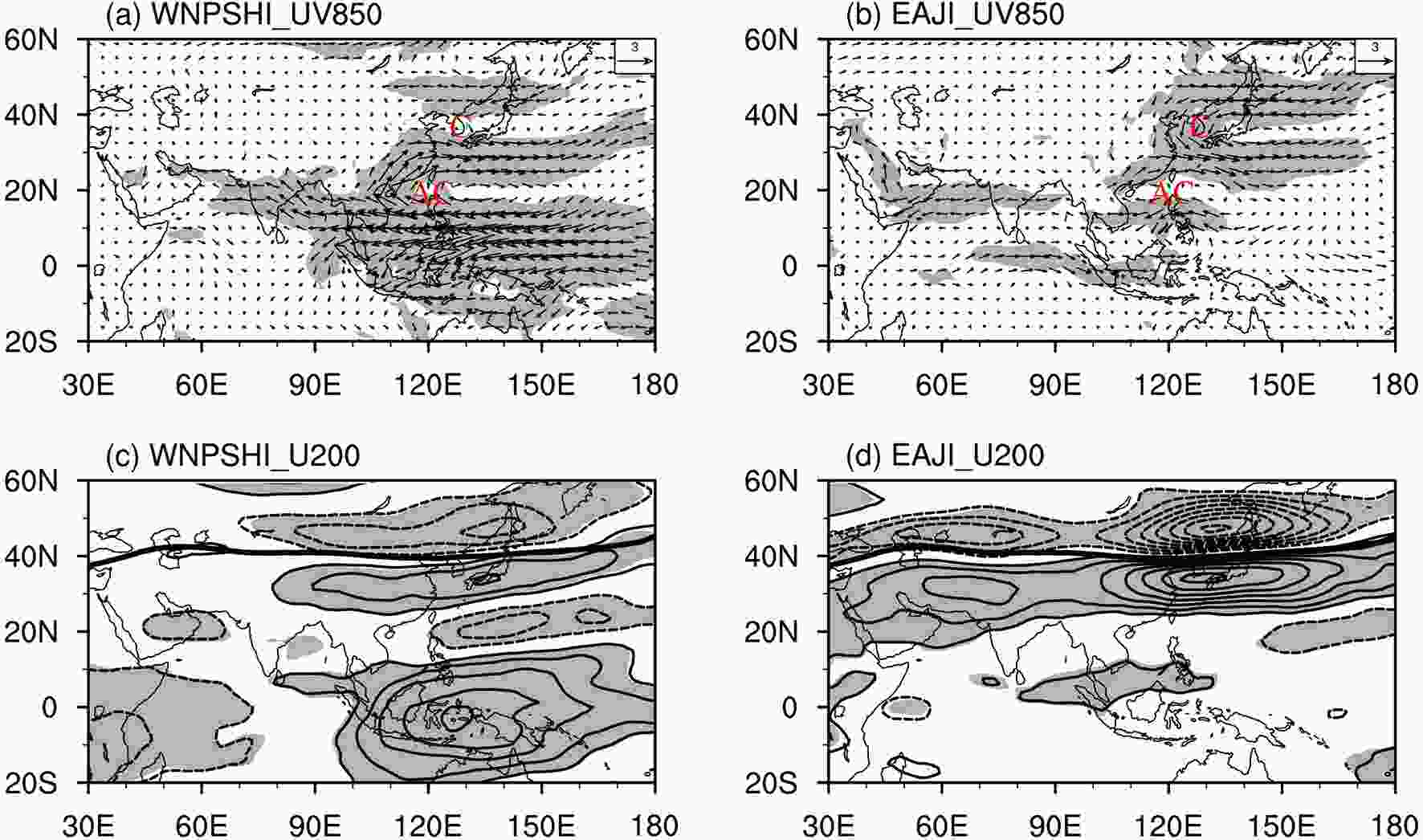 Figure4. Same as Figs. 2 and 3, but for (a, c) WNPSHI+ minus WNPSHI? and (b, d) EAJI+ minus EAJI? cases, respectively. The contour interval in (c) and (d) is 1.0 m s?1, and zero contours are omitted.
Figure4. Same as Figs. 2 and 3, but for (a, c) WNPSHI+ minus WNPSHI? and (b, d) EAJI+ minus EAJI? cases, respectively. The contour interval in (c) and (d) is 1.0 m s?1, and zero contours are omitted.2
3.2. Rainfall anomalies
Figure 5 shows the East Asian rainfall anomalies associated with the in-phase and out-of-phase configurations of the WNPSHI and EAJI, respectively. For the in-phase configuration, rainfall increases significantly over the Yangtze River basin and south Japan and decreases in North China and Northeast Asia (Fig. 5a). However, enhanced rainfall moves northward into North China and the northern Korean Peninsula for the out-of-phase cases (Fig. 5b), corresponding to the northward expansion of the WNP anticyclonic anomaly (Fig. 2b). In addition, rainfall over the Yangtze River basin and south Japan is suppressed for the out-of-phase configuration (Fig. 5b).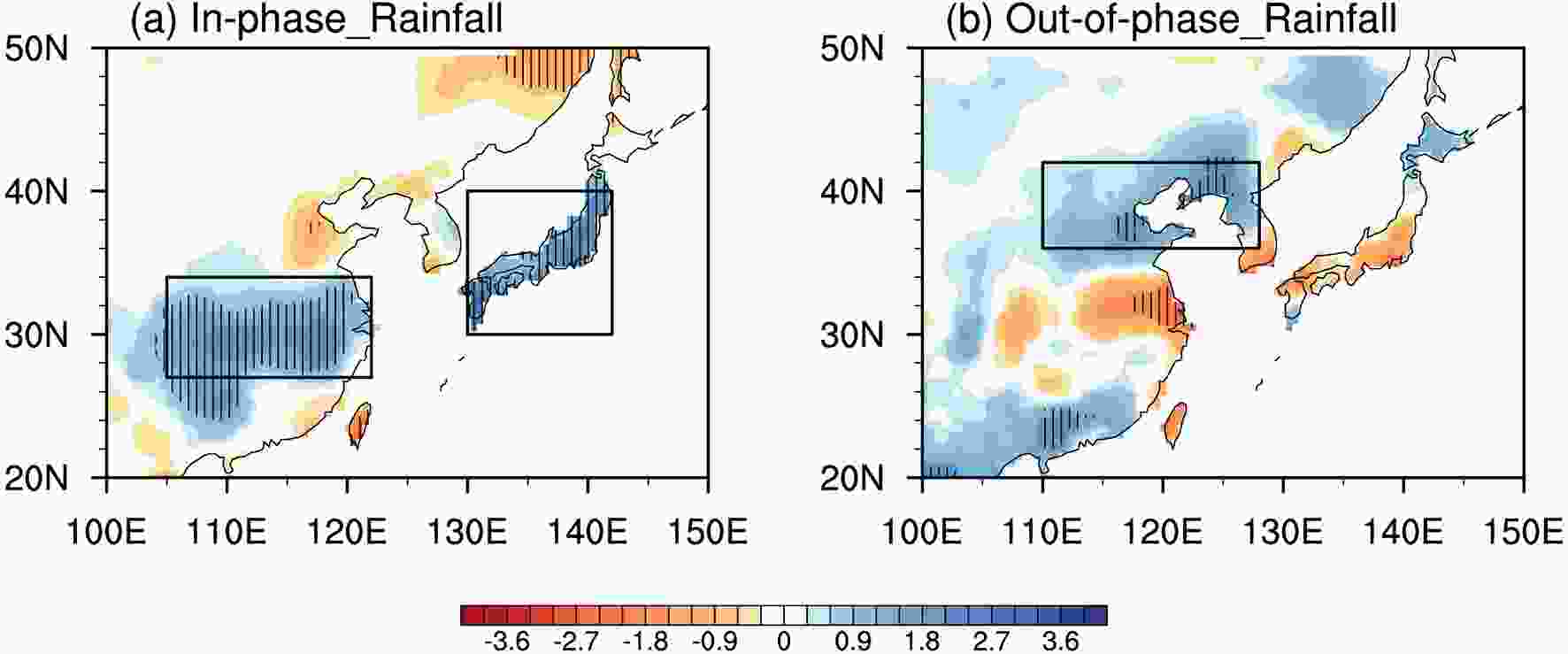 Figure5. Same as Fig. 2, but for CRU rainfall anomalies (units: mm d?1). The marked regions in (a) indicate the Yangtze River basin and south Japan, respectively, and the one in (b) represents North China and the northern Korean Peninsula. Hatching indicates that the anomalies are significant at the 95% confidence level based on a Student’s t-test.
Figure5. Same as Fig. 2, but for CRU rainfall anomalies (units: mm d?1). The marked regions in (a) indicate the Yangtze River basin and south Japan, respectively, and the one in (b) represents North China and the northern Korean Peninsula. Hatching indicates that the anomalies are significant at the 95% confidence level based on a Student’s t-test.Rainfall anomalies associated with the individual WNPSHI and EAJI show great similarities to the in-phase configuration, i.e., there are enhanced anomalies over the Yangtze River basin and South Japan and suppressed anomalies over Northeast Asia (Figs. 6a and 6b), consistent with previous studies (e.g., Wang and Fan, 1999; Zhang et al., 2003; Lu and Lin, 2009; Zhao et al., 2015). However, compared to the individual WNPSHI or EAJI, the anomalies are more intense for the in-phase configuration. For instance, the rainfall anomalies averaged over the Yangtze River basin (27°–34°N, 105°–122°E) for the in-phase configuration are 1.27 mm d?1, stronger than those for the individual WNPSHI (0.74 mm d?1) or EAJI (0.98 mm d?1). Therefore, the in-phase configuration of the WNPSH and EAJ supports weather patterns that are more prone to both floods and droughts over the Yangtze River basin and south Japan. On the other hand, the southward shift of the EAJ results in suppressed rainfall over North China and the northern Korean Peninsula (Fig. 6b). However, compared to the individual effect of the EAJ, an out-of-phase WNPSH–EAJ configuration induces stronger rainfall anomalies over North China and the northern Korean Peninsula: rainfall anomalies averaged over (36°–42°N, 110°–128°E) are 1.15 mm d?1 for the out-of-phase configuration, but only ?0.72 mm d?1 for the individual EAJI.
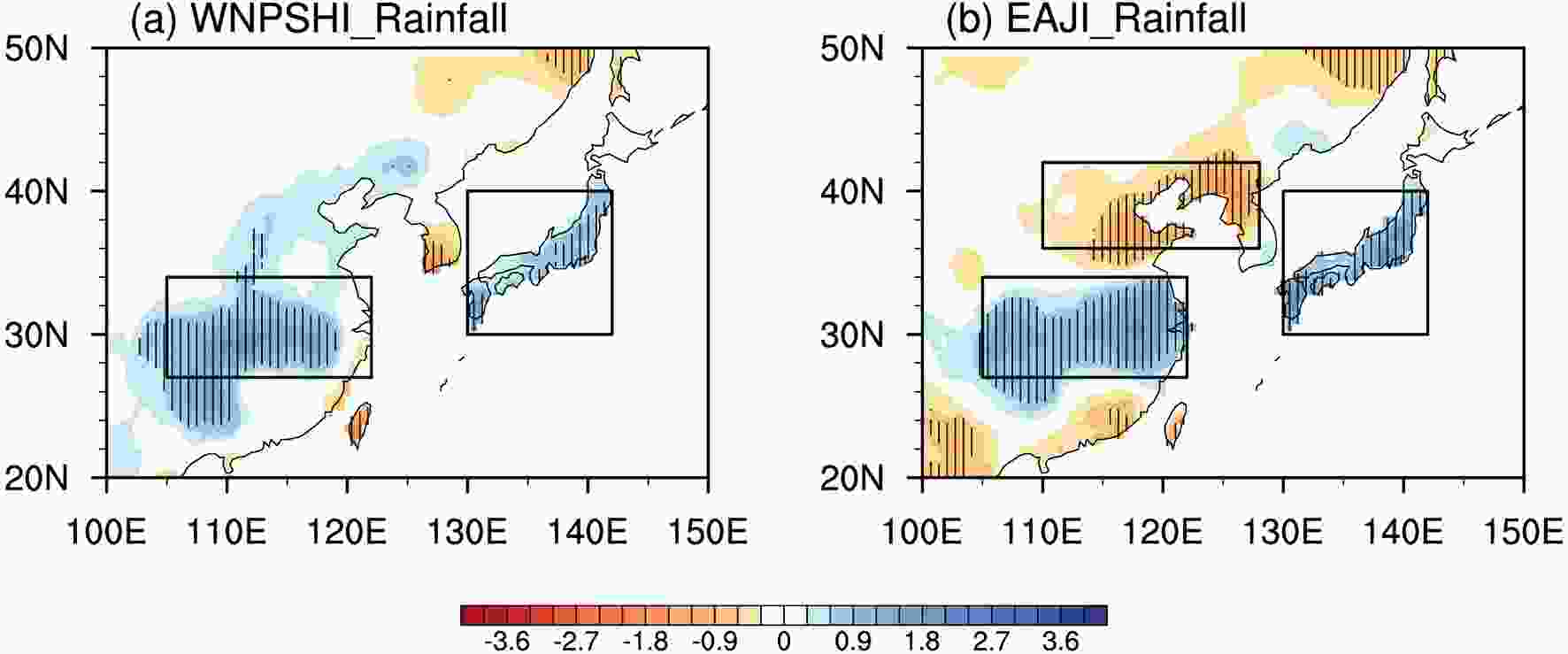 Figure6. Same as Fig. 5, but for (a) WNPSHI+ minus WNPSHI? and (b) EAJI+ minus EAJI? cases, respectively.
Figure6. Same as Fig. 5, but for (a) WNPSHI+ minus WNPSHI? and (b) EAJI+ minus EAJI? cases, respectively.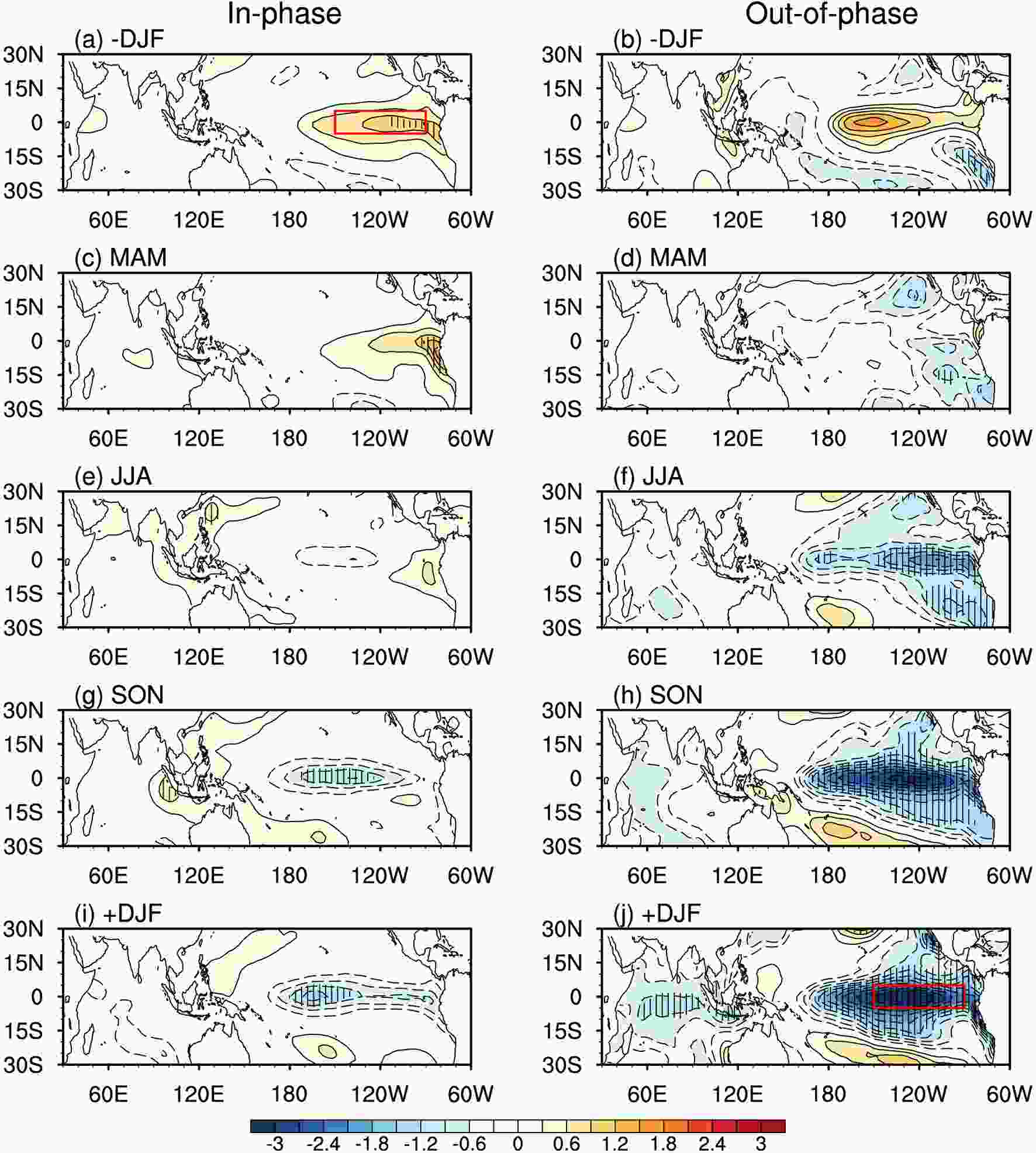 Figure7. Evolution of sea surface temperature (SST) anomalies (units: °C) from the preceding (?DJF) to subsequent (+DJF) winter associated with the (left-hand panels) in-phase and (right-hand panels) out-of-phase configurations of the WNPSHI and EAJI, respectively. Zero contours are omitted. Hatching indicates that the SST anomalies are significant at the 95% confidence level based on a Student’s t-test. Marked regions in (a) and (j) are used to define the Ni?o-3 index in the preceding and the following winters, respectively.
Figure7. Evolution of sea surface temperature (SST) anomalies (units: °C) from the preceding (?DJF) to subsequent (+DJF) winter associated with the (left-hand panels) in-phase and (right-hand panels) out-of-phase configurations of the WNPSHI and EAJI, respectively. Zero contours are omitted. Hatching indicates that the SST anomalies are significant at the 95% confidence level based on a Student’s t-test. Marked regions in (a) and (j) are used to define the Ni?o-3 index in the preceding and the following winters, respectively. Figure8. Same as Fig. 7, but for (left-hand panels) WNPSHI+ minus WNPSHI? and (right-hand panels) EAJI+ minus EAJI? cases, respectively.
Figure8. Same as Fig. 7, but for (left-hand panels) WNPSHI+ minus WNPSHI? and (right-hand panels) EAJI+ minus EAJI? cases, respectively.In contrast, the out-of-phase configuration shows strong and significant negative SSTs in the tropical central and eastern Pacific in simultaneous summer (Fig. 7f), and these anomalies develop further into the following seasons (Figs. 7h and 7j), i.e., the developing phase of La Ni?a. Among the five WNPSHI+ EAJI? cases, four are consistent with the developing phase of La Ni?a, yet all the three WNPSHI? EAJI+ cases are associated with the developing phase of El Ni?o (Fig. 1). The negative SSTs in the tropical central and eastern Pacific in summer are favorable for the WNP anticyclonic anomaly and the northward shift of the EAJ (Lau and Nath, 2006; Lin and Lu, 2009; Lin, 2010; Wang et al., 2013; Kong and Chiang, 2020). In addition, there are negative SSTs in the tropical Indian ocean, which may also contribute to the northward shift of the EAJ (Qu and Huang, 2011).
Compared to the individual WNPSHI, as well as the in-phase configuration, the SSTs for the out-of-phase configuration are much stronger in summer and the following seasons. For instance, the SSTs averaged over the Ni?o-3 region in the following winter are ?1.30°C for the out-of-phase configuration, but only ?0.58°C for the individual WNPSHI. These results suggest that the out-of-phase configuration of the WNPSH and EAJ requires strong external SST forcing during the summer and into the following seasons. It is also notable that the tropical SST evolution is largely anti-symmetric between the two out-of-phase configurations (not shown). That is, the out-of-phase configuration could also be associated with the developing phase of El Ni?o, but with opposite-signed circulation anomalies.
Figure 9 shows the JJA-mean UV850 and U200 anomalies regressed onto the normalized Ni?o-3 index from the previous winter and again upon the negative Ni?o-3 index of the following winter. Note that the following winter Ni?o-3 index here is multiplied by –1 to obtain the anomalies associated with the developing phase of La Ni?a. The UV850 anomalies associated with the decay of El Ni?o are characterized by a significant anticyclonic anomaly over the subtropical WNP (Fig. 9a) and a cyclonic anomaly over the mid-latitudes of East Asia, which is in association with a southward shift of the upper-tropospheric EAJ (Fig. 9c). In addition, the U200 anomalies appear to demonstrate a meridional teleconnection from the tropical to extratropical WNP–EA (Fig. 9c). These anomalies are similar to those associated with the in-phase configuration of the WNPSH and EAJ (Figs. 2a and 3a).
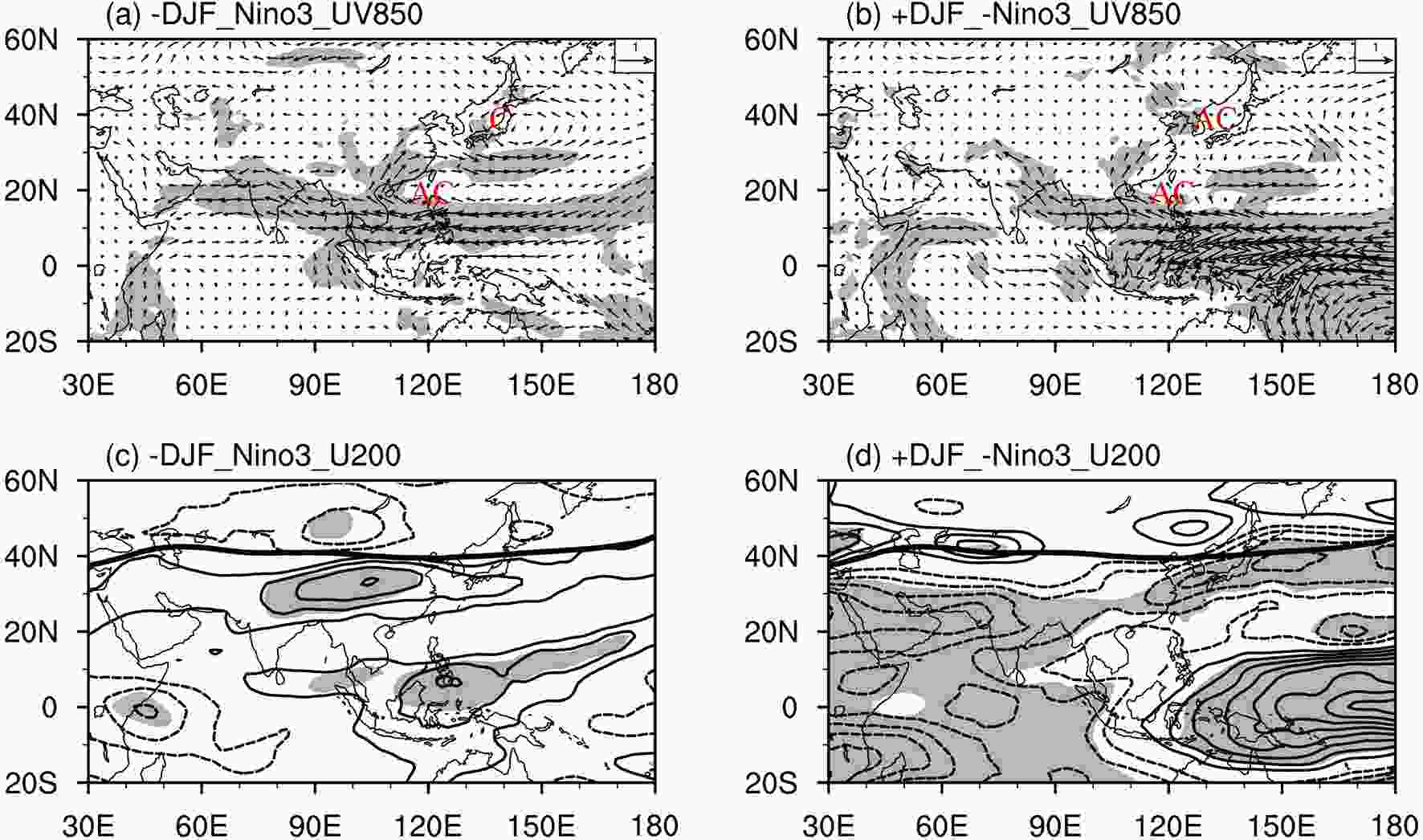 Figure9. Regression of (a, b) 850-hPa horizontal winds (vectors; units: m s?1) and (c, d) 200-hPa zonal winds (contours; units: m s?1) upon the normalized (a, c) Ni?o-3 index of the previous winter and (b, d) upon the negative Ni?o-3 index of the following winter during 1958–2019. Shadings in (a) and (b) indicate that either the zonal or meridional wind anomalies are significant at the 95% confidence level based on a Student’s t-test. “AC” and “C” represent the anticyclonic and cyclonic anomaly, respectively. The contour interval in (c) and (d) is 0.3 m s?1, and zero contours are omitted. The bold black lines represent the climatological jet axis. Shadings in (c) and (d) indicate that the zonal wind anomalies are significant at the 95% confidence level based on a Student’s t-test.
Figure9. Regression of (a, b) 850-hPa horizontal winds (vectors; units: m s?1) and (c, d) 200-hPa zonal winds (contours; units: m s?1) upon the normalized (a, c) Ni?o-3 index of the previous winter and (b, d) upon the negative Ni?o-3 index of the following winter during 1958–2019. Shadings in (a) and (b) indicate that either the zonal or meridional wind anomalies are significant at the 95% confidence level based on a Student’s t-test. “AC” and “C” represent the anticyclonic and cyclonic anomaly, respectively. The contour interval in (c) and (d) is 0.3 m s?1, and zero contours are omitted. The bold black lines represent the climatological jet axis. Shadings in (c) and (d) indicate that the zonal wind anomalies are significant at the 95% confidence level based on a Student’s t-test.By contrast, for the developing phase of La Ni?a (Fig. 9b), which is accompanied by negative SSTs in tropical central and eastern Pacific in summer, there are also anticyclonic anomalies over the subtropical WNP. However, the mid-latitude cyclonic anomaly is absent. Instead, there is an anticyclonic anomaly over north Japan, which corresponds to the northward shift of the upper-tropospheric EAJ (Fig. 9d). The southerly anomalies on the western flank of the anticyclonic anomaly over north Japan merge with those associated with the subtropical WNP anticyclonic anomaly and result in southwesterly or southeasterly anomalies throughout eastern China. These anomalies are in good agreement with previous results (e.g., Wu et al., 2003; Wu et al., 2009; Li et al., 2014; Wen et al., 2019) and show some similarities with the out-of-phase configuration of the WNPSH and EAJ (Fig. 2b). The correlation coefficient between the JJA-mean Ni?o-3 index and the WNPSHI (EAJI) is ?0.26 (0.29), which is statistically significant at the 95% confidence level. These results suggest that the developing phase of La Ni?a is favorable for the out-of-phase WNPSH–EAJ correspondence.
There are similarities and discrepancies between the interannual variation and decadal change of the WNPSH–EAJ relationship in the early 2000s (Li and Lu, 2020). For instance, the in-phase configuration and the close WNPSH–EAJ relationship before the early 2000s are both characterized by the meridional teleconnection and tend to be associated with the decay of El Ni?o; and the out-of-phase configuration and the vague WNPSH–EAJ relationship after the early 2000s feature an anticyclonic anomaly in the lower troposphere and is favored by the simultaneous SST cooling in the tropical central and eastern Pacific. However, compared with those before the early 2000s, the anomalies associated with the in-phase configuration are stronger, as the anomalies in Li and Lu (2020) are based on the individual WNPSHI or EAJI. In addition, compared with the vague WNPSH–EAJ relationship after the early 2000s, the lower-tropospheric anticyclonic anomaly associated with the out-of-phase configuration extends more northward, which results from the northward shift of the EAJ.
It should be mentioned that other factors, in addition to the tropical SSTs, may also affect the WNPSH–EAJ correspondences. For instance, the interaction between circulation and precipitation anomalies over the WNP–EA may play a role. Associated with the in-phase configuration of the WNPSH and EAJ, there is highly significant anomalous rainfall over the Yangtze River basin and south Japan (Fig. 5a), which may, in turn, favor the in-phase WNPSH–EAJ correspondence (e.g., Lu and Lin, 2009). By contrast, the subtropical rainfall anomaly associated with the out-of-phase configuration is weak (Fig. 5b) and thus its feedback to circulation anomalies might also be weakened.
It is found that the in-phase and out-of-phase configurations of the WNPSH and EAJ manifest themselves differently regarding their circulation anomalies and anomalous rainfall patterns over East Asia. For the in-phase configuration, the circulation anomalies are characterized by a typical meridional teleconnection—that is, there are significant anticyclonic (cyclonic) anomalies in the tropical WNP and significant cyclonic (anticyclonic) anomalies in the mid-latitudes of East Asia. These circulation anomalies result in anomalous rainfall over the Yangtze River basin and south Japan, and these rainfall anomalies are stronger than the individual WNPSH or EAJ. For the out-of-phase configuration, the mid-latitude cyclonic (anticyclonic) anomalies are replaced by anticyclonic (cyclonic) anomalies. These mid-latitude anticyclonic (cyclonic) anomalies merge with the tropical WNP anticyclonic (cyclonic) anomalies and form an anticyclonic (cyclonic) anomaly with a large meridional extension. As a result, anomalous rainfall moves northward into North China and the northern Korean Peninsula.
Further results indicate that the tropical SST evolution plays an important role in governing the out-of-phase configuration of the WNPSH and EAJ. The strong and significant negative (positive) SSTs in the tropical central and eastern Pacific that simultaneously occur during summer, in association with the developing phase of La Ni?a (El Ni?o), favor the westward extension (eastward retreat) of the WNPSH and northward (southward) shift of the EAJ and thus lead to an out-of-phase WNPSH–EAJ correspondence. In contrast, the in-phase WNPSH–EAJ correspondence tends to be associated with the decaying phase of ENSO. However, these SSTs are weak and not a necessity for the occurrence of the in-phase configuration.
Currently, climate models show a considerable capability in the seasonal forecasting of the zonal shift of WNPSH (Li et al., 2012, 2014; Kosaka et al., 2013; Shin et al., 2019), which provides an encouraging basis for reliable prediction of East Asian summer rainfall. However, our results suggest that compared to the individual WNPSH, the in-phase (out-of-phase) WNPSH–EAJ configuration is more likely to induce floods and droughts over the Yangtze River basin and south Japan (North China and northern Korean Peninsula). Therefore, to produce a reliable seasonal forecast of East Asian summer rainfall, different configurations of the WNPSH and EAJ should be fully considered. On the other hand, the tropical SSTs for the in-phase configuration are weak, implying a great challenge for the prediction of this configuration. The out-of-phase configuration requires strong SST forcing over the tropical central and eastern Pacific in summer and the following seasons. Therefore, the predictability of in-phase and out-of-phase WNPSH–EAJ configurations may have different sources and be involved in different processes, which is worthy of further investigation.
Acknowledgements. We thank the editor and two anonymous reviewers for their insightful comments, which helped improve the presentation. This work was supported by the National Natural Science Foundation of China (Grant Nos. 41905055 and 41721004), the Natural Science Foundation of Jiangsu Province (Grant No. BK20190500), and the Fundamental Research Funds for the Central Universities (Grant No. B200202145).
